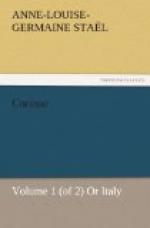“It is from here that we ought to perceive St Peter’s. The pillars before it were to extend as far as here:—such was the superb plan of Michael Angelo; he expected, at least, that it would be so finished after his death; but the men of our days no longer think of posterity. When once enthusiasm has been turned into ridicule every thing except money and power is destroyed.” “It is you who will revive that sentiment,” cried Lord Nelville. “Who ever experienced the happiness I enjoy? Rome shewn by you, Rome interpreted by imagination and genius, Rome, that is a world animated by sentiment, without which the world itself is a desert[9]. Ah, Corinne! what will succeed to these days, more happy than my heart and my fate permit!” Corinne answered him with sweetness: “All sincere affections proceed from heaven, Oswald! Why should it not protect what it inspires? To that Power belongs our fate.”
At that moment St Peter’s appeared to them, the greatest building that man has ever raised; for the pyramids of Egypt themselves are inferior to it in height. “Perhaps,” said Corinne, “I ought to have shewn you the finest of our buildings last, but that is not my system. It is my opinion that to beget a sensibility for the fine arts, we must begin by beholding objects that inspire a deep and lively admiration. This sentiment once felt, reveals, if I may so express myself, a new sphere of ideas, and renders us afterwards more capable of loving, and of judging, what even in an inferior order recalls the first impression we have received. All those gradations, those prudent methods, one tint after another, to prepare for great effects, are not to my taste; we cannot arrive at the sublime by degrees; infinite distances separate it even from that which is only beautiful.” Oswald felt an altogether extraordinary emotion on arriving opposite St Peter’s. It was the first time that the work of man had produced upon him the same effect as one of the wonders of nature. This is the only work of art, now on our earth, possessing that kind of grandeur which characterises the immediate works of the creation. Corinne enjoyed the astonishment of Oswald. “I have chosen,” said she, “a day when the sun is in all its lustre, to shew you this edifice. I have in reserve for you a still more exquisite, more religious pleasure, when you shall contemplate it by moonlight: but you must first witness the most brilliant intellectual feast—the genius of man adorned with the magnificence of nature.”
The square of St Peter is surrounded by pillars—those at a distance of a light, and those near of a massive structure. The ground, which is upon a gentle ascent up to the portico of the church, still adds to the effect which it produces. An obelisk, 80 feet high, stands in the middle of the square, but its height appears as nothing in presence of the cupola of St Peter’s. The form of an obelisk alone has something in it that pleases the imagination;




